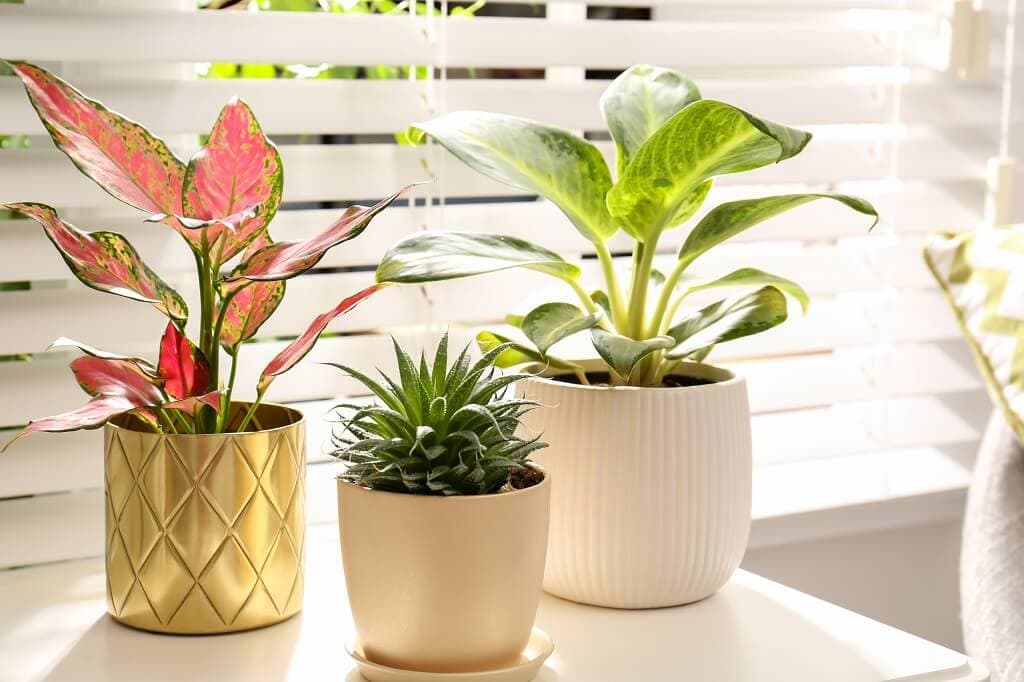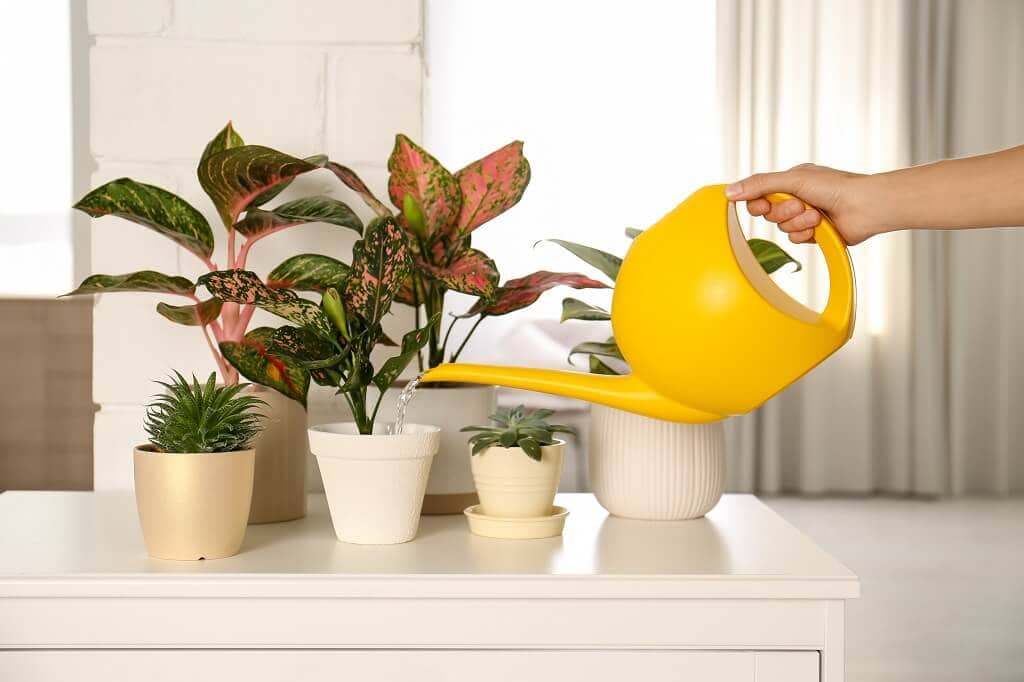Chinese Evergreen Plant Care at Home
In this guide, I’ll run through everything you need to know about Chinese Evergreen plant care at home. Although these plants (aka Aglaonemas) stay green year-round, they’re actually perennial herbs and not a tree. This is one of my favorites for growing at home, thanks to their showy leaves that make a significant visual impact with little maintenance.

Chinese Evergreen Plant Care – Key Takeaways:
| Scientific Name: | Aglaonema commutatum |
| Native Range: | Tropical and subtropical regions of Asia |
| Soil: | Well-draining, houseplant potting mix with a slightly acidic pH |
| Light: | Low to medium indirect light; more for variegated varieties |
| Watering: | Allow the top inch of soil to dry out before watering again |
| Temperature: | Ideal range is between 65-80°F (18-28°C); does not tolerate cold below 60°F (16°C) |
| Fertilizing: | Feed with a balanced liquid fertilizer once a month during the growing season (spring and summer) |
| Pruning: | Prune to maintain desired size and shape; can also propagate from cuttings |
| Pests: | Common pests include spider mites, mealybugs, and scale insects. Mitigate with regular cleaning, appropriate watering, and the use of insecticidal soaps or neem oil if needed. |
| Toxicity: | Toxic to pets and humans, if ingested, can cause mouth and throat irritation. |
How to Grow Chinese Evergreen Plants at Home

Growth Expectations: How Big and How Fast Do Chinese Evergreens Grow?
A Chinese evergreen can grow to about one to three feet tall, depending on the variety. Chinese evergreens grow more quickly in the summer and more slowly during the winter. Compared to other plants, Chinese evergreens grow relatively slowly. Most indoor aglaonema plants only need to be repotted once every two or three years.
Planting Preparation Tips
Having a mini-plan in place before potting or planting at home is always good. Here are 3 points I always consider for new houseplants:
1. Choose a Location
For successful indoor growing, Chinese Evergreen plants should be placed where they will receive low to moderate indirect sunlight. Keep the plant away from heating and air conditioning vents and cold drafts.
2. Select a Container
Obtain a well-draining pot no more than two sizes larger than your plant’s current pot. For example, if your plant currently has a 4-inch pot, choose a 6 or 8-inch container.
3. Gather Supplies
Before you begin, here’s a useful checklist of items you’ll need to get going:
- Houseplant mix
- Sand/peat/perlite
- 5-5-5 fertilizer
- Well-draining container
- Gardening gloves
- Soil probe moisture meter (fingers are a good substitute as well!)
- Secateurs
- Watering can
The Best Soil Mix
Chinese evergreens need well-draining, slightly acidic soil. Make the perfect potting mix by combining store-bought potting soil (formulated for houseplants) with perlite or peat and sand in equal parts. In a pinch, aglaonemas can also survive in cactus soil.
How to Plant
- Select a container two to four inches larger than the plant’s current pot.
- Fill the container 1/4 of the way full with your potting mix. (To encourage proper drainage, you can add a shallow layer of rocks at the bottom of the pot before adding the soil. However, this isn’t necessary with a well-draining container.)
- Gently remove the Chinese evergreen from its current pot.
- Dislodge some of the spent soil from the plant’s roots. However, Chinese evergreens prefer being slightly root-bound, so there’s no need to tease apart its roots.
- Place the plant’s rootball in the new pot on top of the bottom layer of soil.
- Fill in around the plant’s roots with the rest of the soil until the roots are completely covered. Only the plant’s stalk and leaves should show.
- Water thoroughly to compact the soil and add more to the top if needed.
- Allow the pot to drain completely.
- Place the plant in the desired location.
Light Preferences

Chinese evergreens can survive in a variety of light conditions. They make popular office plants because they do well in rooms bathed in fluorescent light only. However, your Chinese evergreen will grow best with moderate, indirect, or filtered sunlight. Avoid bright, direct sunlight in south-facing windows because it scorches and burns the plant’s leaves.
Although Chinese evergreens can tolerate most light conditions, certain varieties (those with vibrant, variegated leaves) do best in bright, indirect light, and others (those with mostly green leaves) fare best in moderate to low light conditions.
Temperature and Humidity Preferences
For optimal Chinese evergreen care, these plants prefer high humidity and don’t tolerate temperatures below 65°F. Keep aglaonemas away from cold drafts and hot air vents that can chill or dehydrate the plant.
If you live in an arid environment, consider running a humidifier in your home or misting your plant’s leaves once every week or two. You can also place a tray filled with pebbles and water beneath your plant’s container to increase the humidity present in its immediate environment.
Essential Chinese Evergreen Care for Optimal Plant Health

Watering
Watering schedules vary based on each plant’s environment (season, temperature, humidity, and light levels). In warmer, drier environments or during the growing season, plants need to be watered more frequently. On average, Chinese evergreens should be watered once every seven to 10 days in the summer and every two weeks in the winter.
Chinese evergreens prefer a damp environment. An aglaonema’s pot should never dry completely. However, leaving one in standing water can cause root rot. Water when the top three inches of soil feels dry. To keep the soil perfectly moist, use a soil moisture meter. Water your plant when the meter reads three or four.
To water, first, fill your watering can. (Instead of tap water, use filtered or distilled water to protect your plant from chlorine and fluoride.) Then pour gently into the plant’s soil, avoiding its leaves. Stop watering as soon as water begins draining from the pot’s bottom.
Feeding & Fertilizing

What to Feed
Aglaonemas prefer a balanced liquid plant fertilizer (5-5-5 or lower), fish emulsion, or liquid kelp. Regardless of what you use, be sure to dilute it to half-strength.
When to Feed
For optimal Chinese Evergreen care, these plants don’t require frequent feeding. Fertilize your Chinese evergreen once a year in early spring. If you think yours needs more food, you can give it a second dose in the summer.
Do not fertilize a Chinese evergreen in the fall or winter. Your plant will go dormant and rest during the cooler months. Do not over-fertilize your plants; doing so can burn the plant’s roots.
Pruning

When to Prune
Chinese evergreens only require pruning to remove spent flowers or yellow/brown leaves.
How to Prune
Use clean pruning shears to trim spent flowers or dead leaves from the plant as close to the stalk as possible. To reduce the risk of exposing your plant to pests, wait to prune until the dead leaves pull away easily.
Propagation
You can propagate Chinese evergreens in two ways:
- Simply split the plant – roots and all – into two sections with at least four leaves apiece and repot both.
- Sprout new plants from leaf cuttings. Cut as many leaves as you want new plants from the original Chinese evergreen. (Choose leaves with at least six inches of the stalk to remove with the leaf.) Simply snip the leaf at its stalk, place it in a cup of water, and wait for it to sprout roots. Then, put it in a small pot with soil and move it to a larger container after additional shoots have sprouted.
Chinese evergreens are most successfully propagated during the growing season (spring and summer).
How to Repot

When to Repot
A Chinese evergreen won’t suffer from being slightly rootbound. If yours has roots sprouting from the bottom of the pot or emerging above the soil, you should still wait until spring or summer to repot the plant.
How to Repot
- Take all your supplies outside or lay down a drop cloth or newspaper to catch the mess.
- Choose a pot that’s three to four inches bigger than the current container.
- Create a well-draining soil mix (potting mix/perlite/peat/sand).
- Fill your new pot 1/4 full with soil.
- Gently remove your Chinese evergreen from its pot. If you have trouble getting it loose, you can use a small trowel or butter knife to separate the soil and rootball from the sides of the pot.
- Don’t worry about teasing the roots apart.
- Place the plant on top of the soil in the new pot.
- Fill soil around the plant until the roots are completely covered.
- Water until it runs out the bottom of the pot.
- Continue care as usual.
Common Chinese Evergreen Problems & How to Treat Them

Look Out for These Common Chinese Evergreen Problems
- Droopy Leaves – The plant might need more water or light. Give both a try and observe the plant for improvement.
- Dark, Greasy Patches – These indicate chill injury. For optimal Chinese evergreen care, move the plant to a warmer location.
- Crisp Leaves with Brown Tips – The plant likely needs more water or humidity. Mist the leaves or add a tray of pebbles with water or a humidifier.
- Curling Leaves – Too much light. Try moving your plant to a shadier location.
- Yellow or Brown Leaves – Your plant might be getting too much water. Use a soil moisture meter for a perfect watering schedule.
- Yellow or Brown Stalks – The plant might have root rot, especially in standing water. Drain excess water from the pot and hold off on watering until the soil has almost dried. Consider applying a root rot treatment if the plant’s condition does not improve.
Common Chinese Evergreen Pests and Diseases
- Mealybugs appear as white fluff on the undersides of leaves, stalks, and soil. Treating them early will prevent them from contaminating other plants in your home. Prune away small infestations or use a cotton swab to dab them with rubbing alcohol. Store-bought insecticide works best for tackling heavy infestations.
- Spider Mites – These tiny orange-colored pests weave sticky webs and damage your plants. Prune away infested sections of your plant or purchase a plant-safe spider mite insecticide from a garden center.
- Scale – You’ll recognize these pests by their shell-like appearance that pops up on leaves and stalks. Scale can only be eradicated with insecticide during one stage of its lifestyle. Often, it’s easier to toss an infected plant before other houseplants are exposed.
Popular Chinese Evergreen Cultivars

Selectively cultivated for their leaf colors and patterns, more than 20 species or cultivars of aglaonemas exist. The most popular include:
- Silver Queen
- Silver Bay
- Golden Bay
- Emerald Beauty
- Calypso
- Firecracker
Are Chinese Evergreens Toxic to Humans and Pets?
All aglaonemas are toxic to humans and pets. All the plant’s parts contain insoluble calcium oxalate crystals. These damage and irritate soft tissues when the plant is ingested or handled roughly. Additionally, certain varieties produce berry-like fruit that can be poisonous. Keep small children and pets away from Chinese evergreens.
Wrapping Up
Versatile, low-maintenance, and beautiful to admire, it’s no wonder why aglaonemas are some of the most popular houseplants. Whether you enjoy them in your home or in an office, Chinese evergreen plant care is a lovely pastime and will surely brighten the atmosphere and lift your mood!
Andrew is the Editorial Director at Petal Republic. He holds a BSc degree in Plant Sciences and has trained professionally at leading floristry schools in London and Paris. In amongst overseeing a global editorial team, Andrew's a passionate content creator around all things flowers, floral design, gardening, and houseplants.
